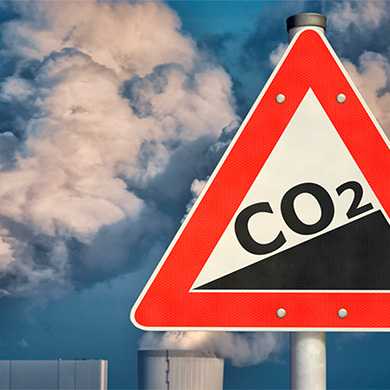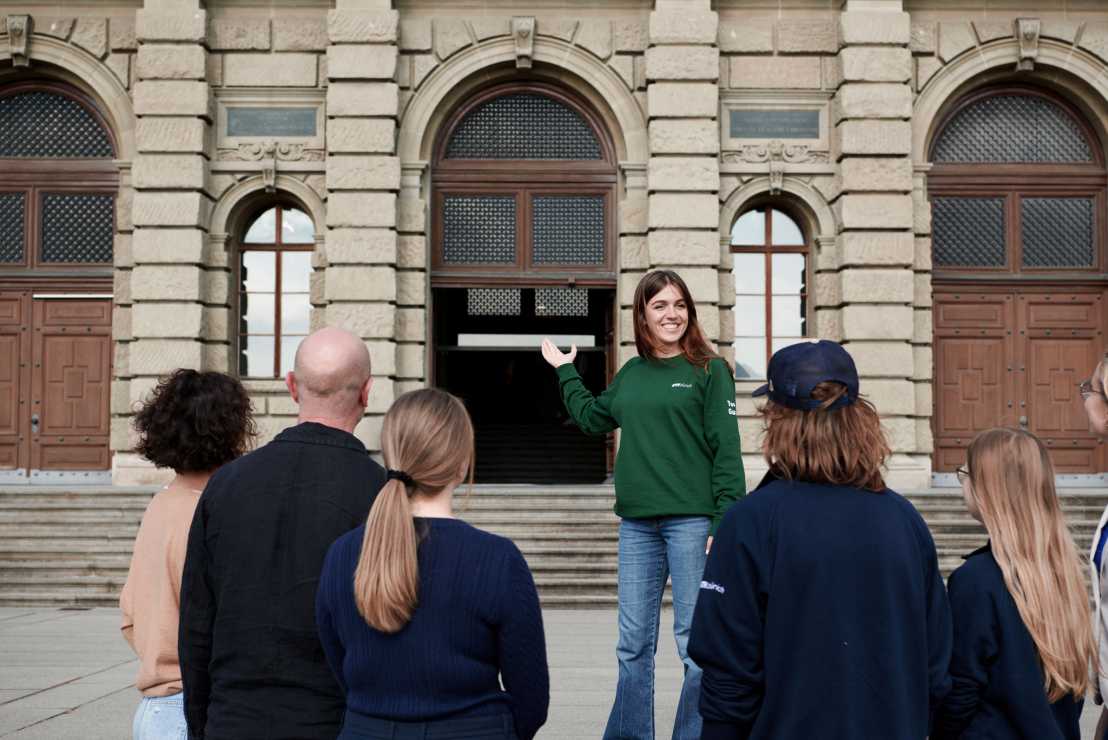Net Zero
At ETH Zurich, we are working to significantly reduce our greenhouse gas emissions by 2030. ETH Net Zero is a task for which we are jointly responsible. The "ETH Net Zero" programme bundles impact-oriented activities for the years 2024 to 2030 to reduce all climate-relevant emissions on campus as well as in teaching and research at ETH as far as possible.

ETH has been implementing climate protection and energy efficiency measures since the early 2000s and has driven forward the reduction of greenhouse gases in our own academic operations with projects and initiatives. Since 2019, the process has been in an intensified exploration phase due to rapidly changing framework conditions at the political and legal level and an internal consultation process within the ETH community.
With the launch of the "ETH Net Zero" programme, all Executive Board domains and departments are mandated to participate. Nine transformative projects (TPs) are running. At the annual Net Zero Day, we will report on the progress made on the reduction path and discuss successes and challenges in the ETH community.
In striving for net zero, the premise is to avoid and to reduce emissions to such an extent that only absolutely "unavoidable emissions" remain. To achieve net zero in the current system boundary (Scope 1, Scope 2, business travel), offsetting certificates may still be purchased until 2030. From 2030, the "unavoidable emissions" will have to be neutralised, i.e. removed from the atmosphere and permanently stored in an appropriate site using CO2 removal technologies co-developed by ETH, among others. The system boundary will be continuously extended as of 2030 for an "all-scope" decarbonisation by 2040.
"ETH Net Zero" programme, 2024-2030

The Download 4-pager on the "ETH Net Zero" programme (PDF, 874 KB) (published: March 2024) summarises the core elements at a glance and invites all ETH members to participate. The "ETH Net Zero" programme is being implemented in an agile and impact-oriented manner and enables continuous further development.

Decarbonized campus

This project pursues the goal of minimising the use of fossil fuels on the campus areas by 2030 and eliminating them completely by 2036. This means that ETH will reduce all activities based on fossil fuels and/or substitute them with renewable energy sources like geothermal or photovoltaics.
Energy efficiency & renewables

Indirect emissions from electricity and district heating purchases (so-called Scope 2 emissions) are minimised by procuring purely renewable, green energy. To date, ETH already purchases electricity from renewable sources and produces ~1% of its electricity through photovoltaics on campus.
Low-emission business travel

Expanding the existing ETH air travel project, the business travel project will focus on moving towards more mindful and sustainable mobility. This includes air, rail and car travel as well as the decarbonization of the ETH vehicle fleet.
Low-emission procurement

The goal of this project is to significantly reduce indirect CO2 emissions from purchased goods and services (Scope 3; excl. business trips) by engaging with suppliers and continuously integrating sustainability criteria in bidding processes and compliance standards.
Scope 3 exploration

The majority of emissions comes from indirect sources along the supply chain, referred to as Scope 3 emissions. This project aims to examine sectors and their product segments such as construction projects, laboratories and gastronomy in order to allow for an effective prioritisation and implementation of emission reduction measures.
Net Zero living labs

ETH offers its campus facilities and infrastructure as a real-world laboratory for research-induced green energy storage and greenhouse gas reduction projects with the goal of net zero and promotes their implementation. An executive board proposal to formalize this process is currently under development.
Example: Carbon capture pilot
Emission reporting

We aim to report our greenhouse gas emissions annually across all three scopes according to internationally recognised standards (in particular the external page GHG Protocol).
Find the latest data on Facts & Figures and details on our methodology to compute emissions in this recent article.
Communication and community engagement

Our goal is to inform all ETH members about the reduction targets and create ways to collaborate and engage on our expedition to Net Zero.
Existing formats: Net Zero Day, Sustainability Summit, Campaigns

There are many definitions of net zero. At ETH Zurich, we follow the external page definition of the IPCC report and the external page lexicon of the external page UNFCCC Race to Zero campaign.
According to the IPCC, the net zero target is reached when anthropogenic emissions of greenhouse gases (GHG) into the atmosphere are balanced by anthropogenic removals over a certain period of time. This means that an individual actor's emissions are reduced in a scientifically sound and verifiable manner, and any remaining GHG emissions attributable to him/her are fully neutralized by like-for-like reductions (e.g., permanent removals for fossil carbon emissions) taken up exclusively by that actor. This can happen either within the value chain or through the purchase of valid offset certificates.
By signing the Paris Climate Agreement in 2015, Switzerland committed itself, together with other nations, to stabilizing global warming at 1.5 degrees Celsius compared to pre-industrial levels. ETH Zurich, as a decentralized unit of the Swiss Federal Administration, is committed to reducing its greenhouse gas emissions by at least 50% until 2030 as part of its minimum target, according to the 2019 Federal Administration Climate Package («Klimapaket»).
For three decades, ETH Zurich has been collecting comprehensive environmental statistics from which greenhouse gas emissions can be calculated. The emission values are published in various reports. Due to different system boundaries, emission factors and reporting standards, the communicated emission values may vary. ETH Zurich strives for maximum transparency on emissions at all locations in Switzerland, relying on continuous analysis and consistent application of emission factors. In the White Paper «Download ETH Zurich strives for net zero by 2030 (PDF, 592 KB)», direct and indirect emissions, including those in the supply chains, were published for the first time. System boundaries were not yet set in the White Paper.
At ETH Zurich, we distinguish between three types of greenhouse gas emissions according to the external page Greenhouse Gas Protocol:
- Direct emissions from buildings and vehicle fleet (Scope 1)
- Indirect emissions from electricity and district heating purchased from third parties (Scope 2)
- Indirect emissions arising in the upstream and downstream value chains (Scope 3)

The decision on the system boundaries and the granularity of the collection method influences the calculation of the climate target values and the net zero point. ETH Zurich's current system boundary for reducing greenhouse gas emissions until 2030 includes heating and cooling of buildings and operation of its vehicle fleet (Scope 1), purchased electricity and district heating (Scope 2), and business travel (air, rail, and car travel; a Scope 3 commodity group).
According to the Climate Package of the Federal Administration, the mandatory minimum target for institutions of the ETH Domain is to reduce emissions from these commodity groups by 50% until 2030 compared to the reference year 2006. At ETH Zurich, the minimum reduction target of 50% is aimed at as the sum of the emissions of the categories mentioned and not per commodity group. Data bases for this minimum target are available and the reduction along the reduction path can be reliably measured.
According to current calculations, emissions from heating and cooling of buildings operation of the vehicle fleet (all Scope 1), purchased electricity and district heating (both Scope 2), and business travel (air travel, rail travel, and car travel; a Scope 3 commodity group) were around 28’200 tCO2eq in the baseline year 2006. The target value in 2030 for emissions within the system boundary of the minimum target is thus around 14’100 tCO2eq.
The so-called unavoidable emissions in the Scope 1 and Scope 2 categories are projected at around 6’700 tCO2eq in 2030. The target value for emissions from business travel in 2030 is calculated from the difference between total emissions and Scope 1 and Scope 2 emissions, and thus amounts to around 7’400 tCO2eq. For business travel this corresponds to a reduction of 48% compared to 2006.
The system boundary of the minimum target for 2030 covers on average only about 15% of the total emissions of ETH Zurich. The indirect emissions in the upstream and downstream supply chains from Scope 3 are excluded from this minimum target until 2030 for the time being (except business travel). The minimum target is nevertheless considered challenging. It includes a technical-infrastructural and a behavioural dimension. Addressing the minimum target will enable the ETH community to rapidly develop additional targets for all its emissions (all scopes). This knowledge, as well as parallel processes and pilot projects, can be used for effects to deal with Scope 3 indirect emissions.
According to the new "external page Federal Act on Climate Protection Targets, Innovation, and Strengthening Energy Security (KIG)", a complete net zero target requires consideration of emissions from all three categories (scopes 1, 2, and 3) (see also external page Net Zero Stocktake).
The external page new Swiss Climate Protection Act, which was approved by the Swiss population on June 18, 2023, includes the following requirement on the Swiss federal administration in Article 10 "Exemplary function of the Confederation and the cantons": "The central federal administration must achieve at least net-zero emissions by the year 2040. In addition to direct and indirect emissions, this also takes into account emissions caused upstream and downstream by third parties."
An ordinance for the decentralized units of the federal administration, which include the institutions of the ETH Domain, is currently being drafted. The ETH Board is involved. For the time being, the 2019 climate package for the federal administration is applicable to ETH Zurich.
Within the system boundary of the mandatory minimum target, ETH Zurich's greenhouse gas emissions have trended downward since 2006. In the year leading up to the pandemic, 2019, a reduction of about 13% was achieved, and in the year following the pandemic, 2022, a reduction of about 33% was recorded. However, in 2023 emissions have seen an uptick, especially due to an increase in business travel.

The data are based on the environmental indicators for Scope 1 and 2 emissions and the activity data for business air, rail and car travel. The emission values are calculated using emission factors based on published values from the Swiss Federal Office for the Environment (FOEN) and the Swiss Federal Office of Energy (SFOE) and electricity and district heating providers. The emissions of ETH Zurich's air travel are calculated in high resolution by the company atmosfair gGmbH as part of the ETH Air Travel Project.
The avoidance and reduction of greenhouse gas emissions at the source is always the highest priority for ETH Zurich. They have an immediate effect and are more cost-effective compared to the outflow of funds to external third parties through compensation payments and investments in projects for negative emissions.
To achieve net zero, emission reductions alone are currently not sufficient. Technological measures in the field of negative emission technologies are also needed. ETH Zurich is working on new negative emissions technologies so that they are available for application as soon as possible. It is particularly committed to pilot projects and demonstrators in Switzerland and Europe.
Currently, ETH Zurich is obliged to offset emissions from the building sector (Scope 1 and 2) (currently around 9’700 tCO2eq per year). Together with the institutions of the ETH Domain, it has been procuring compensation certificates since 2020 via the international certificates procured centrally abroad by the Federal Office for the Environment (FOEN). The basis for this is the Federal Council resolution "Concept for the financial management of the Federal Administration Climate Package - Part Compensation Abroad" of spring 2022. The CO2 Ordinance ("Ordinance on the Reduction of CO2 Emissions", Section 5) defines the processes according to which the FOEN procures certificates and the requirements they must meet.
Unavoidable emissions will therefore still be compensated for the time being. The aim is for ETH Zurich to be able to forego offsetting as much as possible after 2030 (see also Download White Paper "ETH Zurich strives for net zero by 2030" (PDF, 592 KB)).
To date, ETH Zurich has taken various measures in all three scopes to reduce its greenhouse gas emissions.
Scope 1 emissions
Our goal is to have a fossil-free campus. With investments and construction in the anergy grid on the Hönggerberg and photovoltaic installations, ETH Zurich has already achieved significant reductions in CO2 emissions. The supercomputer data center in Lugano is equipped with a heating/cooling lake water pipeline. The ETH Zentrum-Hönggerberg bus line (eLink) was fully electrified in 2021.
Scope 2 emissions
In 2012, we set ourselves the goal of permanently increasing the share of renewable electricity. Through the target agreement with the Energy Agency for Industry (EnAW), we are obliged to become more energy efficient every year. This is overseen by the EnAW using a monitoring system.
Scope 3 emissions
We reported the emissions that we can only control indirectly for the first time on the 2017 data basis in accordance with the guidelines of the Greenhouse Gas Protocol. Based on this, we will make targeted adjustments to our requirements for suppliers and service providers and change our behaviour regarding sustainable procurement, consumption reduction (e.g., for laboratory supplies), life cycles for equipment use (e.g., for scientific apparatus), sharing and virtualization, construction, waste disposal, and recycling. The biggest levers for reducing Scope 3 emissions are in the commodity groups of real estate and infrastructure, laboratory supplies and scientific equipment, ICT hardware and software, and business travel.
Currently, the system boundary for emission reductions according to the 2019 Climate Package of the Federal Administration applies to the institutions of the ETH Domain. The draft roadmap "ETH Net Zero", which includes measures for the reduction of Scope 3 emissions, was widely consulted with the ETH community in summer 2023.
On 14 March 2024, the ETH Executive Board decided to launch the "ETH Net Zero" programme. Prepared over a long period of time and in collaboration with the ETH community, ETH is now specifying its milestones on the reduction pathway for the years up to 2030 and is setting the course for the challenges beyond 2030 with foresight. In doing so, it is also taking into account the dynamic legal principles and framework conditions and is demonstrating consistency in its role as an innovative and forward-looking institution. ETH is doing this by identifying paths to a climate-compatible future and transferring relevant knowledge, technology and experience to society.

The programme governance for "ETH net zero" takes account of the legal mandate, the breadth of topics, the complexity of the subject matter and the expectations of ETH members. This will enable stronger networking between all areas of the Executive Board and with the interdisciplinary competence centres and specialised research groups.
The programme steering committee meets twice a year under the chairmanship of the Vice President Infrastructure and Sustainability to discuss progress and agile planning. The programme manager ensures the effective implementation of the "ETH Net Zero" programme. He coordinates the programme, supports the design of all aspects of the sub-projects and ensures that they are aligned with the programme objectives. The transformative projects are managed by the lead units, organised in a lean and effective manner. A Sounding Board supports the anchoring of the "ETH Net Zero" programme in the ETH community and in the discourse on net zero.

“I'm counting on you. Together we can do it.”Prof. Dr. Joël Mesot, ETH Zurich President
Programme steering committee
Sounding Board
Programme management and project leads
Sustainability Stories from the ETH Universe - register now for the Sustainability Newsletter!
Who, if not us
Our actions and inactions regarding climate change define our future. We all need to question our habits and adapt our behaviour so that ETH Zurich can become climate neutral.
«All for Zero 2030» is therefore not only an invitation, but an explicit request to all ETH members to actively participate in the necessary transformation towards a more climate-friendly ETH Zurich.
N.B. The statements in the video were recorded in November 2022 and January 2023. Under rapidly changing conditions and clarifications in ETH Zurich’s net zero implementation efforts, specific terms may have different connotations today.
Avoid, reduce and neutralise
We want to achieve the minimum target until 2030 using our own resources by massively expanding existing reduction measures and driving efficiency improvements.
We will combine our scientific expertise and innovative power, put them into practice on campus, and further promote the technological development of negative emission technologies such as CO2 storage.
We make all possible efforts to increase our ambition. We build on bottom-up efforts, for example, so that ETH researchers can further reduce their air travel and ensure that their research is as carbon neutral as possible. The framework and implementation plans are continuously clarified and sharpened.

Learn about the challenges and achievements of ETH Zurich in the reduction of greenhouse gas emissions on the campus during our guided one hour walk over the Hönggerberg campus.
This tour can also be booked for private groups or teams: Information and inquiry
Next date
September 2, 2025, 6:15 pm

The Download White Paper "ETH Zurich strives for net zero by 2030" (PDF, 592 KB) explains what climate neutrality means for the University and how it intends to achieve this goal. It was published in October 2022 and marked the start of a community-wide consultation process.
Contact
ETH Zurich
ETH Office of Sustainability
Weinbergstrasse 41
8092 Zürich
Switzerland
